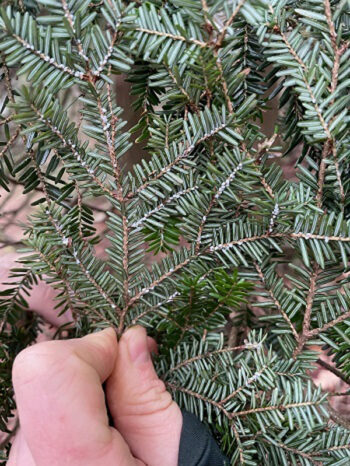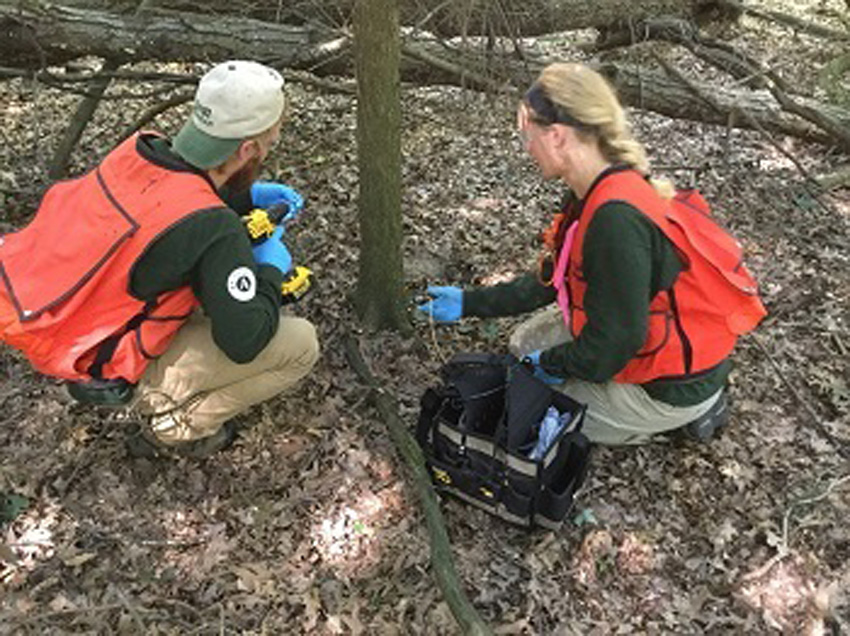REGION- If hemlock trees on your property show signs of hemlock woolly adelgid infestation, now is a good time to plan for spring treatment of this invasive species. Hemlock woolly adelgid, native to Asia, is known to be present in areas of Allegan, Benzie, Mason, Muskegon, Oceana, and Ottawa counties in Michigan. These small insects suck sap from hemlock needles and ultimately can cause tree death.
Insecticides are available to control the insect, and in many cases, landowners can apply them easily by carefully following label instructions and application rate guidance. In Michigan, the label is the law. Due to certain restrictions on the use of these insecticides, you may need the services of a licensed pesticide application business.
If one or more trees are infested, make plans to act this year. Without treatment, trees infested with hemlock woolly adelgid are likely to die within four to 10 years. Weakened trees on a home landscape could spell disaster during high winds or storms, and eventually they will have to be removed. Loss of hemlocks in forested areas can reduce shade, winter cover, food and habitat for birds, fish and mammals.
Products containing either imidacloprid or dinotefuran as the active ingredient and labeled for treatment of hemlock woolly adelgid are effective in combatting the insect.
- Imidacloprid moves slowly through trees, taking at least a year to reach the top of a large tree. However, one application will protect the tree for approximately four years.
- Dinotefuran moves through hemlock trees more quickly, making it ideal for heavily infested trees. Dinotefuran protects trees for one to two years.
No matter which treatment you select, be sure your treatment plan includes all hemlocks on your property over the next few years. If hemlock woolly adelgid is on your site, hemlocks without symptoms are very likely to be infested over time. This includes trees on your property as well as neighboring properties. It’s a good idea to discuss treatment plans with neighbors and coordinate efforts when possible.
Can I treat trees myself?
Application of imidacloprid or dinotefuran is simple enough for many landowners to do themselves. Products containing these chemicals are available at garden supply stores, packaged under various trade names in liquid or granular form. Check the label or ask for assistance in selecting the right product.

Imidacloprid and dinotefuran products available at garden supply stores generally are applied to the soil close to the tree trunk, where they are absorbed through the root system. Plan your application for a time between early April and late October when the ground has thawed and soil moisture is moderate – not too dry or saturated. The sooner you treat, the more successful your treatment will be. Follow all label directions, wear appropriate safety gear and determine the right application rate to ensure positive results. To protect the environment, do not allow pesticide to enter or run off into storm drains, drainage ditches, gutters or surface waters.
Some products have restrictions on the amount that can be applied to an area per year. Be sure to read the label carefully to determine if the amount you need falls within these limits. If not, you may need to adopt a multiyear plan or hire a professional.
When should I call a professional?
Licensed pesticide application businesses have a broader range of options for applying treatments than consumers, and their professional skills are recommended in certain situations.
If your hemlock trees are within 75 feet of a body of water or in areas with a high-water table, or if flowering plants or shrubs are growing around the hemlocks you wish to protect, a trunk injection or bark treatment may be necessary to avoid affecting the environment, groundwater or other insects. Professional applicators can provide these types of treatments.
What should I expect after treatment?
Hemlock woolly adelgid’s cottony, white ovisacs will linger for a time following treatment. If trees are treated in the spring with dinotefuran, check new growth in late fall or winter for any fresh signs of infestation. With imidacloprid, wait until a year after treatment to gauge effectiveness.
After treatment, trees should be checked every year. If the insect has returned after dinotefuran was used, reapplication may be needed after one to two years. For imidacloprid, consider retreatment every four to seven years.
Do my trees have hemlock woolly adelgid?
If you have hemlock trees on your property, it is important to check them for signs of hemlock woolly adelgid, which infests only hemlock trees. If you are not sure whether your trees are hemlocks, use the Michigan Invasive Species Program’s Eastern Hemlock identification guide.
The adelgid’s round, white, cottony ovisacs are most visible in the winter and are located on the undersides of hemlock branches at the base of the needles.


